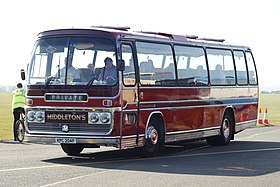Bedford Y series
| Bedford Y Series | |
|---|---|
 A Bedford YRQ with Plaxton Panorama Elite bodywork | |
| Overview | |
| Manufacturer | Bedford |
| Production | 1971 - 1986 |
| Assembly | Luton |
| Body and chassis | |
| Doors | 1-2 |
| Floor type | Step entrance |
| Chassis | Straight ladder frame |
| Powertrain | |
| Engine | Bedford Perkins Leyland Cummins |
| Transmission | 4-speed synchromesh 5-speed |
| Chronology | |
| Predecessor | |
The Bedford Y series was a family of single-decker bus and single-decker coach chassis manufactured by Bedford from 1970 to 1986, when Bedford ceased bus and truck production.
History
[edit]Announced in September 1970, the Bedford YRQ was a 10-metre (33 ft) coach chassis intended to replace the Bedford VAM. The engine was mounted centrally under the floor.
In 1972 an 11-metre (36 ft) version, the YRT, entered production as a replacement for the twin-steer Bedford VAL.[1]
New more powerful engines were introduced in 1975 with the YLQ (10m) and YMT (11m).
The 1980 YNT was a development of the YMT with a turbocharged engine,[2] while the YLQ became the YMQ and then the YMP.
The 12-metre YNV Venturer with air suspension was the final development of the Y series, announced in 1984.
Bus and truck production by Bedford ceased in 1986.[3]
Chassis summary
[edit]
The Y series was produced in four different lengths; 8m, 10m, 11m and 12m. The majority were bodied as coaches, though the 8m, 10m and 11m versions were also built as single-decker buses and midibuses. Seating capacities varied, but were typically 45 for a 10m bus or coach and 53 for an 11m. The 12m version was built almost exclusively as a coach, with one exception where a Plaxton Paramount coach body shell was fitted out with bus seats in a high-capacity layout.[4]
- Bedford Y series
- Eight metres
- YMP/S
- Ten metres
- YRQ
- YLQ
- YMQ
- YMP
- Eleven metres
- YRT
- YMT
- YNT
- Twelve metres
- YNV Venturer
- Eight metres
Model codes were part of a system introduced by General Motors in 1968. Under this, the first letter (in this case, Y) denoted the basic model range; the second letter denoted the engine type; and the third letter the gross weight range for a complete vehicle. Those applicable to the Y series were as follows:[5]
|
|
A further four digits or letters denoted wheelbase, transmission and body type, and the full seven-character code was incorporated in the VIN for each individual vehicle.
The Bedford Y series was sold extensively in the United Kingdom, mainly to independent operators, as well as in export markets. It was fitted with a wide variety of bodies by different manufacturers, chiefly Duple and Plaxton.
References
[edit]- ^ Mid-engine Bedford YRT replaces VAL Commercial Motor 30 June 1972
- ^ YNT 'good Commercial Motor 25 Oct 1980
- ^ Bedford Buses and Coaches By Nigel R B Furness, The Crowood Press Ltd, 2016
- ^ Bus Lists On The Web
- ^ Broatch, Stuart Fergus; Townsin, Alan (October 1996). The Bedford Story, part two - 1950-1986. Glossop: Venture Publications. p. 97. ISBN 1-898432-09-0.
subsidiary of Vauxhall Motors | |
| Cars and leisure vehicles | |
| Vans | |
| Lorries | |
| Buses | |
| military vehicles | |
Text is available under the CC BY-SA 4.0 license; additional terms may apply.
Images, videos and audio are available under their respective licenses.
